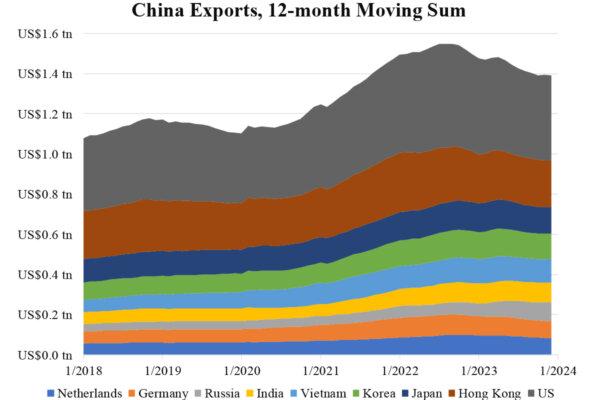Commentary
China’s exports in March decreased by 7.5 percent year-over-year, surpassing the 7.1 percent increase in February, resulting in nearly zero growth over these two months. Previous months saw fluctuations around zero, with numbers ranging from +2.3 percent to -6.4 percent. This stagnant trend has persisted since late 2022, spanning approximately 1.5 years. This aligns with the global trade trend, which experienced a peak in early 2022 before entering a contraction phase from mid-2023 to the first quarter of this year.
Pinpointing the exact causes of this recent trend is challenging due to the limited timeframe for analysis. However, two intuitive hypotheses can be proposed. Firstly, economic factors such as high global inflation have dampened both domestic and international demand. Secondly, political issues like geopolitical tensions and regional conflicts have disrupted trade links, either physically or diplomatically, with the latter playing an increasingly significant role.
This trend does not bode well for China’s “world factory” status, as these countries traditionally excelled in providing inexpensive products rather than high-value ones. A shift occurred a decade ago when BRICs countries began to prosper, hinting at the potential for a closed supply-demand loop. However, Russia and China’s ambitions shattered this dream, prompting Western nations to take notice and react to their actions.

Can China sustain its exports without Western support? The chart illustrates China’s exports in 12-month moving sum amounts with its top eight partners. The U.S. leads the list, followed by Hong Kong, with the latter mostly re-exporting for China and thus can be discounted due to similar final destinations as China’s direct export partners.
Further down the list are Japan, Korea, Vietnam, India, Russia, Germany, and the Netherlands. While Vietnam and Russia lean towards supporting China, the remaining partners belong to Western allies or are considered “friends of America.” India, initially appearing neutral, emerged as China’s largest direct export competitor, with ongoing border conflicts exacerbating tensions. As global alliances polarize, most major export partners of China may align with Western allies, potentially impacting China’s exports significantly.
Currently, the U.S. has reduced imports from China, as indicated. If other partners are compelled to choose sides, the overall threat to China’s exports could be substantial. In 2023, China’s total exports amounted to US$3.4 trillion, with these top eight partners accounting for nearly half. Therefore, the U.S.’ influence on China’s total exports is substantial, and China’s rigid trade negotiation stance could lead to a substantial decline.
Please rewrite the following passage for me.
Source link





